Anatomia da madeira de Xylosma tweedianum (Clos) Eichler (Flacourtiaceae)
DOI:
https://doi.org/10.5902/2179460X26775Palavras-chave:
Anatomia da Madeira, Flacourtiaceae, Xylosma, Xylosma tweedianum.Resumo
O presente trabalho descreve a estrutura anatômica da madeira de Xylosma tweedianum (Clos) Eichl. São fornecidos dados quantitativos e histométricos do xilema secundário, além de ilustrações do tecido lenhoso. As principais caracteristicas observadas correspondem ao descrito na literatura para a família Flacourtiaceae e gênero Xylosma. Destaca-se as placas de perfuração simples, a ausência de parêncquima axial, os raios marcadamente heterogêneos, as fibras libriformes e a presença de elementos vasculares muito longos, com espessamentos espiralados.Downloads
Referências
COPANT - COMISSÃO PANAMERICANA DE NORMAS TECNICAS. Descrição macroscópica, microscópica e geral da madeira – esquema I de recomendação. Colômbia, 1973. 19 p. (COPANT 30).
DIMITRI, M.J. Encliclopedia Argentina de Agricultura y Jardineria. Buenos Aires: Ed. ACME S.A.C.I., 1980. 1161 p.
DUJARDIN, E.P. Eine neue holz-zellulosenfaerbung. Mikrokosmos, n. 53, p. 94,1964.
FREUND, H.H. Handbuch der Mikroskopie in der Technik. Frankfurt: Umscham Verlag, 1970. 375 p.
GOMES, A.V., MARCHIORI, J.N.C. Estudo anatômico da madeira e da casca de Prockia crucis L. (Flacourtiaceae). Ciência e Natura, v.3, n. 3, p. 45-58,1981.
KLEIN, R.M., SLEUMER, H.O. Flacourtiáceas. In: REITZ, R. Flora Ilustrada Catarinense. Itajaí, Herbário Barbosa Rodrigues, 1984. 96 p.
LOMBARDO, A Flora arborea y arborescente dei Uruguay. Montevideo: Concejo Departamental, 1964. 151 p.
MARCHIORI, J.N.C. Estudo anatômico do xilema secundário e da casca de algumas espécies dos gêneros Acacia e Mimosa, nativas no Estado do Rio Grande do Sul. Curitiba, Universidade Federal do Paraná. Curso de Pós-Graduação em Engenharia Florestal, 1980. 186 f. Dissertação de Mestrado.
MARCHIORI, J.N.C., GOMES, AV. Anatomia da madeira e da casca de Casearia rupestris Eichl. In: Anais do IV Congresso Florestal Estadual. Nova Prata, 1980. p. 225-237.
METCALFE, C.R., CHALK, L. Anatomy of the Dicotyledons. Oxford: Clarendon Press, 1972. 1500 p.
MILLER, R.B. Systematic Anatomy of the Xylem and comments on the relationships of Flacourtiaceae. Journal of the Arnold Arboretum, v. 56, n. 1, p. 20-102, 1975.
MUÑOZ, J., ROSS, P., CRACCO, P. Flora indígena dei Uruguay. Montevideo: Ed. Hemisferio Sur, 1993. 284 p.
RECORD, S.J., HESS, R.W. Timbers of the New World. New Haven: Yale University Press, 1949. 640 p.
SLEUMER, H. Las Flacourtiáceas Argentinas. Lilloa, Tucuman, v. 26, p. 5-56,1953.
TEIXEIRA, L.L. Identificação botânico-dendrológica e anatômica de seis espécies euxilóforas do sudoeste paranaense. Curitiba, Universidade Federal do Paraná. Curso de Pós-Graduação em Engenharia Florestal, 1977. 112 f. Dissertação de Mestrado.
Downloads
Publicado
Como Citar
Edição
Seção
Licença
Para acessar a DECLARAÇÃO DE ORIGINALIDADE E EXCLUSIVIDADE E CESSÃO DE DIREITOS AUTORAIS clique aqui.
Diretrizes Éticas para Publicação de Revistas
A revista Ciência e Natura está empenhada em garantir a ética na publicação e na qualidade dos artigos.
A conformidade com padrões de comportamento ético é, portanto, esperada de todas as partes envolvidas: Autores, Editores e Revisores.
Em particular,
Autores: Os Autores devem apresentar uma discussão objetiva sobre a importância do trabalho de pesquisa, bem como detalhes e referências suficientes para permitir que outros reproduzam as experiências. Declarações fraudulentas ou intencionalmente incorretas constituem comportamento antiético e são inaceitáveis. Artigos de Revisão também devem ser objetivos, abrangentes e relatos precisos do estado da arte. Os Autores devem assegurar que seu trabalho é uma obra totalmente original, e se o trabalho e / ou palavras de outros têm sido utilizadas, isso tem sido devidamente reconhecido. O plágio em todas as suas formas constitui um comportamento publicitário não ético e é inaceitável. Submeter o mesmo manuscrito a mais de um jornal simultaneamente constitui um comportamento publicitário não ético e é inaceitável. Os Autores não devem submeter artigos que descrevam essencialmente a mesma pesquisa a mais de uma revista. O Autor correspondente deve garantir que haja um consenso total de todos os Co-autores na aprovação da versão final do artigo e sua submissão para publicação.
Editores: Os Editores devem avaliar manuscritos exclusivamente com base no seu mérito acadêmico. Um Editor não deve usar informações não publicadas na própria pesquisa do Editor sem o consentimento expresso por escrito do Autor. Os Editores devem tomar medidas de resposta razoável quando tiverem sido apresentadas queixas éticas relativas a um manuscrito submetido ou publicado.
Revisores: Todos os manuscritos recebidos para revisão devem ser tratados como documentos confidenciais. As informações ou ideias privilegiadas obtidas através da análise por pares devem ser mantidas confidenciais e não utilizadas para vantagens pessoais. As revisões devem ser conduzidas objetivamente e as observações devem ser formuladas claramente com argumentos de apoio, de modo que os Autores possam usá-los para melhorar o artigo. Qualquer Revisor selecionado que se sinta desqualificado para rever a pesquisa relatada em um manuscrito ou sabe que sua rápida revisão será impossível deve notificar o Editor e desculpar-se do processo de revisão. Os Revisores não devem considerar manuscritos nos quais tenham conflitos de interesse resultantes de relacionamentos ou conexões competitivas, colaborativas ou outras conexões com qualquer dos autores, empresas ou instituições conectadas aos documentos.






